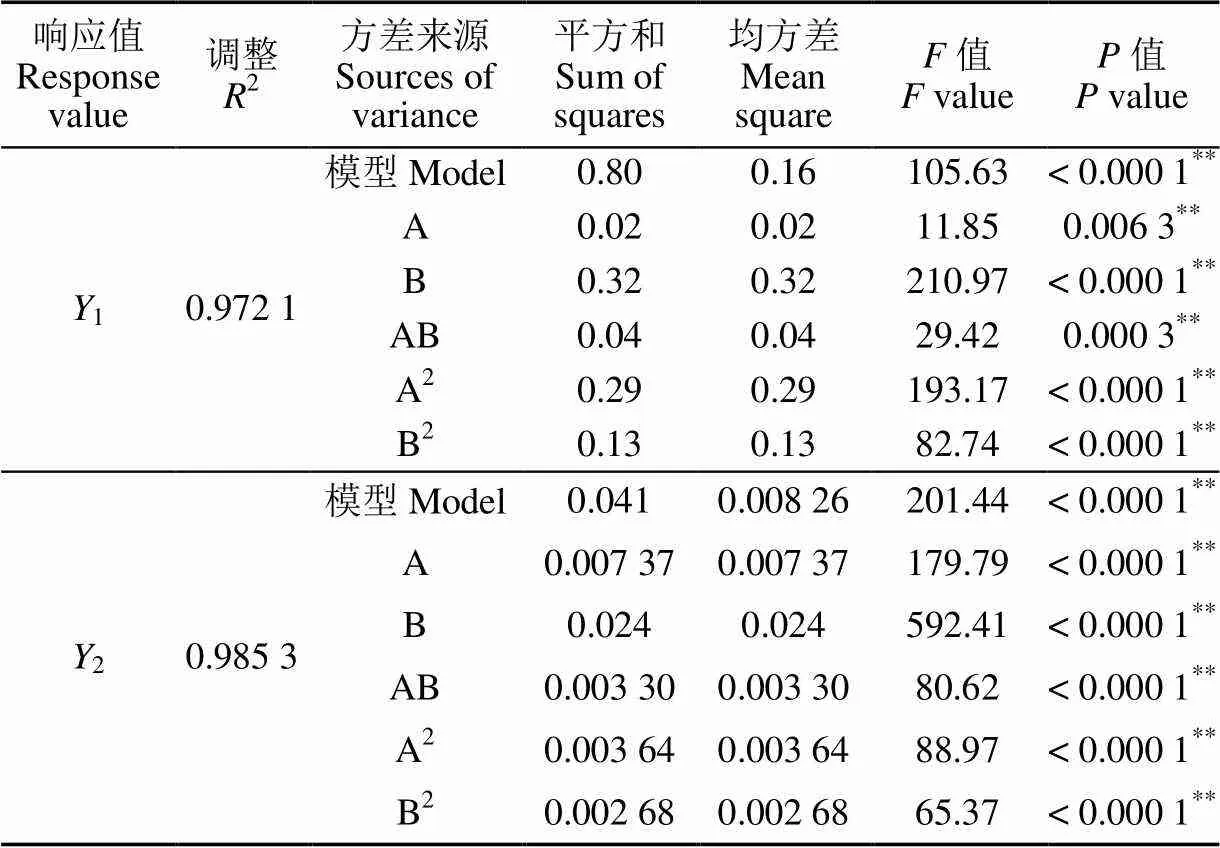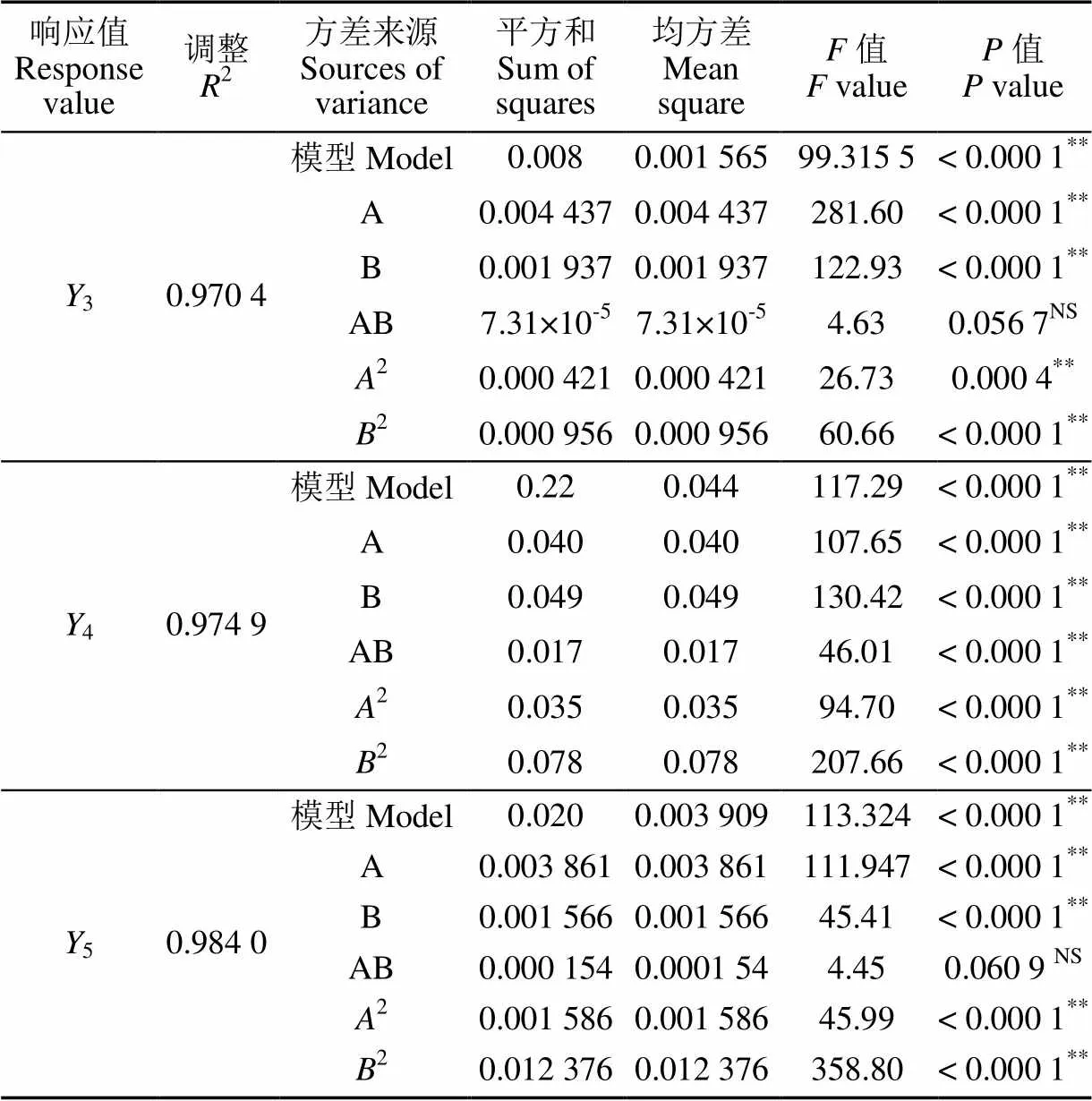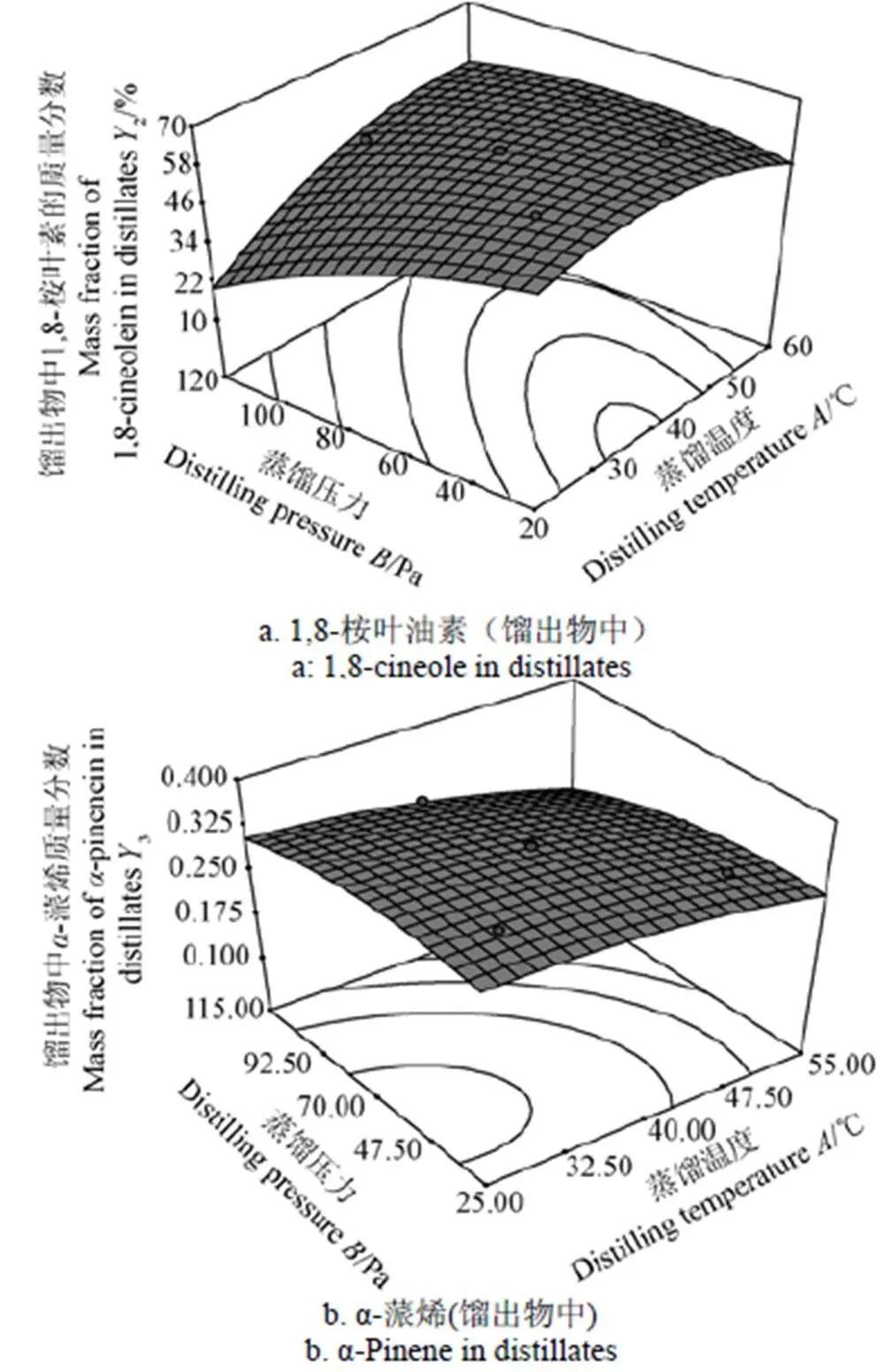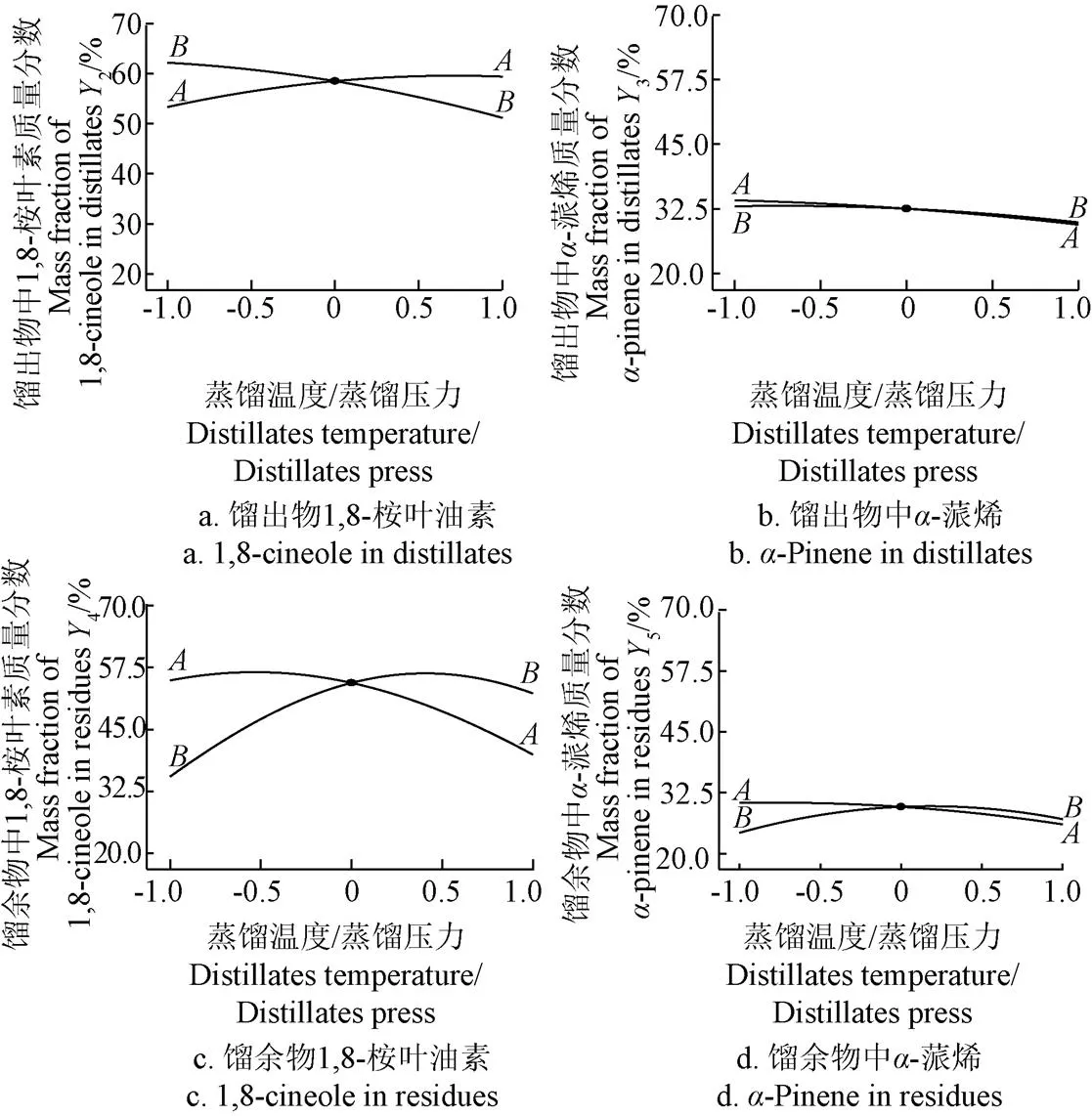短程分子蒸馏技术精制巨尾桉叶精油工艺优化
2018-02-28胡雪芳田志清裴海生张志民王士奎
胡雪芳,田志清,裴海生,张志民,王士奎
短程分子蒸馏技术精制巨尾桉叶精油工艺优化
胡雪芳,田志清,裴海生,张志民,王士奎※
(1. 农业部规划设计研究院农产品加工工程研究所,北京 100125;2. 农业部农产品产后处理重点实验室,北京 100121)
为了优化巨尾桉叶精油精制工艺,采用短程分子蒸馏,对初级桉叶精油中1,8-桉叶素和-蒎烯进行精制,研究不同温度和压力条件下2种物质分离特性。以巨尾桉叶为试验材料,依次采用超临界CO2萃取和分子蒸馏对其进行桉叶油树脂提取和纯化得到初级桉叶精油,采用二因素五水平的响应面优化试验,将馏出物得率、馏出物中1,8-桉叶油素质量分数及-蒎烯质量分数、馏余物中1,8-桉叶油素质量分数及-蒎烯质量分数作为试验指标,对分子蒸馏精制桉叶精油工艺进行优化研究。最优纯化工艺条件:以馏出物为目标产物,蒸馏温度38 ℃,蒸馏压力41 Pa,馏出物中1,8-桉叶油素和-蒎烯的质量分数分别约为60.80%和31.58%,馏出物的得率为82.06%。分子蒸馏能够对桉叶精油进行有效的纯化精制,桉叶初级精油经过二级分子蒸馏精制后,1,8-桉叶油素和-蒎烯的质量分数分别提高了77.62%和56.72%。蒸馏温度和蒸馏压力对1,8-桉叶油素质量分数的影响均较-蒎烯明显,同时,对于1,8-桉叶油素,蒸馏压力的变化对其质量分数的影响较蒸馏温度明显,相反的,对于-蒎烯,蒸馏温度对其质量分数影响更为显著(<0.05),该研究结果可为分离提纯2种物质提供技术参考。
蒸馏;压力;温度;桉叶精油;1,8-桉叶油素;-蒎烯;工艺优化
0 引 言
桉树是中国最重要的经济树种之一,在中国广西、广东、云南等20多个省、市、自治区均有种植,面积已超过360万hm2[1]。在桉树种植区,大量桉叶作为木材生产的主要废弃物几乎未被加工利用,造成优质生物质资源的极大浪费。桉叶油是桉树叶油腺细胞分泌出来的芳香精油,主要为萜品烯类化合物、芳香族类化合物和脂肪族类[2-5],是世界上十大精油品种之一。桉叶油具有抑菌消炎[6-7]、抗氧化[8-10]、抗肿瘤抗病毒[11-12]、杀虫等活性[13-15],在食品、化工、医药、环境和能源等领域有广泛应用[16-17]。
目前国内外对植物精油分离提取的方式主要有水蒸气蒸馏法[18]、超声波(微波)辅助提取法[19-21]、有机溶剂萃取法、超临界提取法[22-24]和分子蒸馏等[25-30]。水蒸气蒸馏法是最常用的方法,具有设备简单、成本低等优点,但是由于需要较高的温度,可能会使热敏性成分发生热分解,降低了精油产品质量;溶剂提取法具有操作简单、产率高等特点,但是此方法由于溶剂残留难以完全除去,一般适用于精油粗品提取;超临界萃取法作为一种新型绿色的气体-液分离技术,萃取速度快、效率高、能耗少,但设备投资较大,操作要求高,用简单的超临界萃取方法无法生产高纯度的产品,还应考虑与其他分离、纯化技术相结合[31-33]。中国作为世界桉叶油的主要供应国和出口国,开发新型高效桉叶油分离纯化技术,提高其产品附加值有着重要意义。分子蒸馏(molecular distillation,MD)又称为短程蒸馏(short path distillation, SPD),是随着真空技术及真空蒸馏技术的发展而逐渐发展起来的一种特殊的液-液分离技术,它的原理是在高真空度条件下操作,依据分子运动平均自由程的差别,具有蒸馏压力低、操作温度低、受热时间短、分离效率高等优点,特别适用于高分子量、高沸点、高粘度、热敏性及易氧化物系的分离[34-37]。中国对于分子蒸馏技术的研究起步较晚,近年来作为精制、纯化、除蜡手段在植物精油提取领域的研究成为热点,在但是关于蒸馏参数对分馏物组分影响尚缺乏深入研究,在桉叶精油分离提取方面的应用研究甚少,1,8-桉叶油素和-蒎烯是桉叶精油的主要组分,在医药化工领域有着重要的应用。本文运用分子蒸馏技术对这2种物质进行分馏纯化,探究不同操作参数下馏出物和馏余物中馏分组成的变化,并且以精油得率、1,8-桉叶素和-蒎烯质量分数作为指标,对工艺参数进行优化,旨在为桉叶精油的精制提供新的工艺思路和参考。
1 材料与方法
1.1 试验材料
巨尾桉桉叶,由桂林集琦生化有限公司提供;正己烷(色谱级);1,8-桉叶素标准品(1,8-cineole,纯度≥98%);-蒎烯标准品(-Pinene,纯度≥98%),正十二烷标准品(Dodecane),购于美国Sigma-Aldrich公司。
1.2 仪器与试剂
2英寸刮膜式分子蒸馏器(美国Pope科学公司),安捷伦GC-7890A气相色谱仪(美国安捷伦公司),BSA124S-CW电子天平(量程:120 g,精度:0.1 mg,德国Satorious公司),二氧化碳流体萃取装置(大连卓尔高科技有限公司)。
1.3 试验方法
1.3.1 桉叶初级精油的制备
桉叶油树脂由超临界二氧化碳流体萃取装置,从巨尾桉桉叶中提取。CO2纯度:99.99%。超临界流体萃取条件如下:40 MPa萃取压力、温度50 ℃,60目粉碎粒度、CO2流速30 kg/h,分离压力:8 MPa,分离温度:60 ℃、提取时间2.5 h。桉叶油提取率为15.47%。初级分子蒸馏纯化过程:量取桉叶油树脂500 mL,加入进料瓶中,打开排气阀,关闭进料阀,打开真空泵,将系统压力设置为40 Pa,对物料进行脱气工序。脱气完成后,设置蒸馏温度50 ℃,蒸馏压力90 Pa,刮膜速度250~300 r/min,进料速度1滴/s,冷却水温度10 ℃,进料温度35 ℃,所得桉叶精油得率为39.43%,1,8-桉叶素和-蒎烯质量分数分别为34.23%和20.15%。
1.3.2 定量测定方法
1,8-桉叶素和-蒎烯质量分数用气相色谱仪测定,色谱柱选取DB-5毛细管柱(30.0 m×0.25 mm×0.25m),气谱条件为:载气高纯度氮气(99%),流速1.0 mL/min,进样口温度250 ℃,采用FID检测器,检测器温度290 ℃,空气流速为300 mL/min,氢气流速30 mL/min。采用内标标准曲线法,以1,8-桉叶油素、-蒎烯与内标物的质量浓度比为纵坐标(),峰面积比为横坐标(),进行性回归分析计算结果。
1.3.3 中心旋转复合设计
采用中心旋转复合设计(central composite rotating design, CCRD)对分子蒸馏精制桉叶精油工艺进行优化研究。将馏出物得率(1)、馏出物中1,8-桉叶油素质量分数(2)及-蒎烯质量分数(3)、1,8-桉叶油素质量分数(4)及-蒎烯质量分数(5)作为试验指标,考察蒸馏温度与蒸馏压力在试验过程中对各试验指标的影响,以得到最佳的工艺条件,分子蒸馏工艺其他试验参数:刮膜速度250 r/min,进料速度1~2滴/s(3~4 mL/min),冷却水温度5 ℃,进料温度30 ℃。因素水平编码见表1。
1.4 数据处理
用Design expert(8.0.6,.,MN,USA)软件对试验数据进行拟合与统计分析,利用Duncan新复极差法对差异显著性进行分析。

表1 中心组合设计各因素水平
2 结果与分析
2.1 试验结果
优化试验结果如表2所示,所有试验数据平行测定3次取平均值。蒸馏温度及蒸馏压力对各个响应值影响的方差分析及预测模型的回归分析结果分别见表3。
表2试验结果

Table 2 Experiment results
注:1、2、3、4与5分别为馏出物得率,馏出物中1,8-桉叶油素质量分数,-蒎烯质量分数,1,8-桉叶油素质量分数,-蒎烯质量分数。

表3 蒸馏温度(A)与压力(B)对各响应值影响的方差分析

续表
注:**代表<0.01,*代表0.01<<0.05,NS代表不显著。
Note: ** means<0.01, * means 0.01<<0.05, NS means not significant.
2.2 馏出物得率响应面分析
图1a是蒸馏压力、蒸馏温度及其交互作用对馏出物得率影响的响应面模型图。

图1 蒸馏温度和蒸馏压力对精油得率影响的响应面和微扰曲线分析
从图1a可以看出,在蒸馏温度35 ℃、蒸馏压力30 Pa左右馏出物得率最高。通过微扰曲线分析,进一步探讨了自变量对响应值影响的变化规律(图1b),参考点为优化设计空间的中点(T=40 ℃,P=70 Pa),由曲线可以看出,馏出物得率随着温度升高呈现先上升后下降的趋势,这是由于随着温度的升高,大量的轻分子组分因为得到足够的能量,其分子平均自由程变长,从而被冷凝器收集而进入馏出物中。相反的,当温度继续升高(>40℃)的时候,一部分分子由于碰撞频繁和激烈,在冷凝面和蒸发面之间做无规则运动,无法及时被冷凝面收集,另外其质量分数在蒸馏体系内达到过饱和状态,通过薄膜蒸发进入外置冷凝器中,导致馏出物得率的下降。由曲线可以看出,馏出物得率随着蒸馏压力的增加而下降,这是因为随着压力的不断升高,物质分子的平均自由程迅速降低,越来越多的组分无法被冷凝器捕集到,使馏出物的得率变小[38]。由表3可以看出,蒸馏温度及其平方项、蒸馏压力及其平方项、以及两者的交叉项对馏出物得率的影响都达到极显著水平。
馏出物得率的二次回归模型为(编码水平)
1=+0.78+0.047−0.20+0.11−0.192−0.132(3)
方程的矫正2为0.97,说明该方程模拟良好。
2.3 蒸馏温度及蒸馏压力对1,8-桉叶油素和α-蒎烯质量分数的影响分析
2.3.1 馏出物中1,8-桉叶油素和-蒎烯质量分数响应面分析
根据试验结果,得出馏出物中1,8-桉叶油素质量分数与各因素之间关系的二阶回归方程(编码水平)如下。
2=+0.59+0.030−0.055+0.029−0.0212−0.0182(4)
3=+0.33−0.024−0.016−7.256×10-32−0.0112(5)
1,8-桉叶油素模型矫正2=0.985 3,-蒎烯模型矫正2=0.964 0,回归方程与响应值具有高度的拟合性。从表3的方差分析可以看出,蒸馏温度及其平方项,蒸馏压力及其平方项以及蒸馏温度与蒸馏压力的交互项对1,8-桉叶油素质量分数的影响均达到极显著水平(<0.01),蒸馏温度、蒸馏压力及其平方项对-蒎烯质量分数的影响达到极显著水平,而温度的平方项、温度及压力的交互项对其影响不显著。
由图2a响应曲面图可以看出,1,8-桉叶油素质量分数随着蒸馏压升高逐渐降低,随着蒸馏温度的升高呈现先升高后降低的趋势,在试验设计空间内,蒸馏温度30~40℃和蒸馏压力30~40 Pa的区域内,1,8-桉叶油素的质量分数达到最高值。由图2b可看出,-蒎烯随着蒸馏温度及压力的升高均呈现下降趋势,因此,低温低压的蒸馏体系更有利于提取-蒎烯。
2.3.2 馏余物中1,8-桉叶油素和-蒎烯质量分数响应面分析
馏余物中1,8-桉叶油素质量分数与各因素之间关系的二阶回归方程如下
4=+0.74−0.055+0.064−0.051−0.0512−0.0782(6)
5=+0.30−0.021+0.014−0.0142−0.0392(7)
馏余物中1,8-桉叶油素和-蒎烯模型矫正2值均大于97%,表示响应值中97%以上变异可以由自变量来解释,两个模型可以准确测定1,8-桉叶油素和-蒎烯的质量分数。由表3的方差分析得出,蒸馏温度,蒸馏压力以及两者的平方项和交互项对馏余物中1,8-桉叶油素和-蒎烯质量分数的影响都达到极显著水平(<0.01)。

由图2c,2d可看出,低温高压条件下更有利用馏余物中1,8-桉叶油素、-的的富集。在温度35℃、压力93 Pa左右馏余物中1,8-桉叶油素质量分数达到最大值,-蒎烯质量分数在30℃和75 Pa左右参数条件下达到最大。
2.4 分子蒸馏过程中1,8-桉叶油素与α-蒎烯分子分离特性研究
微扰曲线(perturbation plot)可在响应优化曲面特定区域比较各自变量对响应值的影响[39],本文将参考点设为优化设计空间的中点(T=40℃,P=70 Pa),进一步探讨了蒸馏温度与蒸馏压力对两种物质分子分离特性的影响。
2.4.1 蒸馏温度对2种物质质量分数变化的影响
从图3a,3b,3c和3d中的曲线可以看出,在馏出物和馏余物中,蒸馏温度对2种物质的质量分数的影响都呈负相关。在馏出物中,1,8-桉叶油素质量分数随着温度的升高而升高,在馏余物中,随着蒸馏温度的升高,1,8-桉叶油素质量分数呈逐渐下降趋势,这是因为随着温度的增加,1,8-桉叶油素分子因为获得足够的热量而被冷凝器捕集进入馏出物。-蒎烯质量分数的变化则较为复杂,由图3b、图3d可以看出-蒎烯质量分数随着温度的升高均呈下降趋势。究其原因,由于-蒎烯其分子的易挥发特性,蒸馏过程中,随着温度升高会有一部分通过薄膜蒸发进入外置冷凝器中,同时蒸发温度的升高,使得蒸汽分子到达冷凝面冷凝时释放大量的冷凝热,使冷凝液膜表面温度上升,导致冷凝面的液膜表面分子再蒸发速率增大[40],降低了-蒎烯的富集效率,越来越多-蒎烯分子从馏余物中逸出,在蒸发面和冷凝面之间的气相空间内做无规则的分子碰撞,无法被冷凝面有效富集,造成了馏出物中-蒎烯质量分数的下降。
2.4.2 蒸馏压力对2种物质质量分数变化的影响
从图3a,3b,3c和3d中的曲线可以看出可以看出,在馏出物与馏余物中,蒸馏压力对2种物质的质量分数的影响呈正相关。在馏出物中,随着蒸馏压力的升高两种物质的质量分数均下降。在馏余物中,2种物质的质量分数随着压力的升高而不断升高,在90 Pa左右达到峰值,而后呈下降趋势。这是由于随着系统压力的上升,2种物质的产率迅速下降,越来越多的1,8-桉叶油素和-蒎烯分子因为分子平均自由程太小无法被冷凝面捕集,而停留在馏余物中。而当蒸馏压力超过90 Pa的时候,很多小分子物质也开始无法充分到达冷凝面而被富集在馏出物中,降低分馏效果,导致1,8-桉叶油素质量分数和-蒎烯质量分数同时下降。
另外,从图3a、3b、3c、3d的、曲线弧度、以及表3方差分析中的值大小可以看出,在馏出物及馏余物中,蒸馏温度和蒸馏压力对1,8-桉叶油素质量分数的影响均较-蒎烯明显,同时,对于1,8-桉叶油素,蒸馏压力的变化对其质量分数的影响较蒸馏温度明显,相反的,对于-蒎烯,蒸馏温度对其质量分数影响更为显著,且温度与压力的交互作用对-蒎烯质量分数的影响不显著,这可为分离提纯2种物质提供了一定的技术参考。

图3 蒸馏温度和蒸馏压力对馏出物、馏余物中1,8-桉叶油素、α-蒎烯质量分数影响的微扰分析
2.5 最终优化与验证
采用Design Export7.0中多响应值优化数据处理系统对蒸馏温度和蒸馏压力进行了优化,分别以馏出物和馏余物作为目标产物,以获最高的1,8-桉叶油素质量分数和-蒎烯质量分数,并兼顾纯化产品得率较高作为优化指标,进行优化设计和验证试验。由表4可以看出,方案一:以馏出物为目标产物,以获高质量分数1,8-桉叶油素和-蒎烯(2、3),高得率馏出物(1)作为优化指标、得到最佳的操作参数为:蒸馏温度38 ℃,蒸馏压力41 Pa,在此条件下,馏出物中1,8-桉叶油素和-蒎烯的质量分数分别为60.80%±0.67%和31.58%±0.44%,馏出物的得率为82.06%±0.85%,1,8-桉叶油素和-蒎烯质量分数分别提高了77.62%和56.72%;方案二:以馏余物为目标产物,以获最高质量分数1,8-桉叶油素和-蒎烯(3、5),高得率馏余物(1-1)作为优化指标,得到最佳的操作参数为:蒸馏温度28℃,蒸馏压力86 Pa,馏余物中1,8-桉叶油素和-蒎烯的质量分数分别为57.90%±0.72%和31.71%±0.39%,馏余物的得率为75.48%±0.45%。其中,方案一所得优化产物中1,8-桉叶油素和精油得率分别比方案二高出2.90%、6.58%,-蒎烯质量分数相当,因此就产品纯度及得率来讲,方案一工艺条件优于方案二,但方案一所需蒸馏温度高于方案二10℃、蒸馏压力低于方案二45 Pa(真空度高于方案二45 Pa),因此从节能方面、对设备的保护性以及操作便易性方面考虑,方案二略有优势。本试验中选取方案一作为最终优化方案。

表4 最优工艺参数及验证试验结果
注:验证试验重复3次。
Note: Verification testing data were mean values of triplicate determinations.
3 讨 论
不同桉树品种挥发油质量分数及成分存在很大差异[41]。比如,窿缘桉和尾叶桉挥发油主要化学成分(>10%)为-蒎烯和1,8-桉叶油素[42-43],柠檬桉叶油的化学成分主要是香茅醛[5]、蓝桉叶油主要化学成分为1,8-桉叶油素,本研究采用的巨尾桉,其桉叶挥发油主要成分为1,8-桉叶油素和-蒎烯,与周莉君等测定结果一致[44,2]。国内外对于桉叶挥发油主成分提纯的研究集中在对1,8-桉叶油素的提纯,王健英等[45-47]利用水蒸气蒸馏法提纯1,8-桉叶油素,但由于桉叶油对热、氧较敏感,长时间与水共沸易引起氧化、聚合等变性反应,很难保持挥发油原有品质。应安国等[48]采用间歇真空精馏技术对桉叶油粗品进行多步骤分离得到的1,8-桉叶油素质量分数在99%上,但其采用的桉叶油为多次精馏后的产品,初始浓度高达75.48%,因此其间歇精馏效果有待考究。张广求等[49-50]利用减压蒸馈法和熔融结晶法串联将1,8-桉叶油质量分数分别提高了45.0%和58.41%,以上研究涉及两种单元操作,工艺耗时长,且结晶的效果较差;栾国颜等[51]通过添加第3组分提纯-蒎烯,此方法涉及外来组分的添加,为后续纯化带来一定麻烦。郭文生等[52]利用包结物晶析法纯化辛夷挥发油中的1,8-桉叶油素,得到质量分数>98%的1,8-桉叶油素,但是过程操作繁琐,一次只能处理3 g辛夷挥发油,效率较低。刘文婷[53]等利用低温控温结晶法分离提纯1,8-桉叶油素,将原料由63.24%提升至了89.63%,但产品收率仅为4.13%。且对于桉叶精油的分离与纯化,其过程通常占生产成本的50%~70%,甚至高达90%[54],步骤多、耗时长,往往成为制约生产的瓶颈。
本研究主要应用分子自由程理论,从响应值的变化趋势初步探讨了蒸馏温度与蒸馏压力对1,8-桉叶油素和-蒎烯的分离特性。由于关于分子蒸馏过程的基础理论研究很少,分子蒸馏过程研究涉及到流体的流动、传热、传质等很多问题,而刮膜式分子蒸馏器内的流体流动及传热传质过程非常复杂,进料速度、刮膜速度、物料组成与性质对蒸馏效率及蒸馏过程中桉叶精油中各组分在体系中的分配都有着不同程度的影响[55-56],且关于应用分子蒸馏技术纯化分离1,8-桉叶油素和-蒎烯的研究较少,利用分子蒸馏进一步分离1,8-桉叶油素和-蒎烯研究有待进一步探讨。
4 结 论
本试验以提高1,8-桉叶油素和-蒎烯纯度作为双指标,采用分子蒸馏对桉叶初级精油进行了进一步精制,综合考察了蒸馏温度与蒸馏压力对馏出物得率,馏出物中1,8-桉叶油素质量分数和-蒎烯质量分数,馏余物中1,8-桉叶油素质量分数和-蒎烯质量分数的影响,得到最优精制工艺条件:以馏出物为目标产物,蒸馏温度38 ℃,蒸馏压力41 Pa,在此条件下,馏出物的得率为82.06%,馏出物中1,8-桉叶油素和-蒎烯的质量分数分别约为60.80%和31.58%,较一级分子蒸馏所得初级桉叶精油中质量分数分别提高了77.62%和56.72%。在工艺方面,分子蒸馏法与传统分离方法相比,可最大限度保持物料纯天然特性,操作简单,可明显降低能耗,节约时间,提高分离效率。
[1] 黄承标,杨锦仁,魏国余,等. 桉树林地枯枝落叶层的水文恃性及养分贮量[J]. 福建林学院学报,2011,31(4):289-294.
Huang Chengbiao, Yang Jinren, Wei Guoyu, et al. Hydrological characteristics and nutrient storage of litterfall in Eucalyptus sp. plantation[J]. Journal of Fujian College of Forestry, 2011, 31(4): 289-294. (in Chinese with English abstract)
[2] 黄增. 巨尾桉有效成分的提取分离及其生物活性研究[D]. 南宁:广西大学,2012.
Huang Zeng. Study on the Extraction, Separation Technology and Bioactivity of Effective Components From Eucalyptus GrandisE.urophylla[D]. Nanning: Guangxi University, 2012. (in Chinese with English abstract)
[3] Macedo I T, Bevilaqua C M, De Oliveira L, et al. Anthelmintic effect of eucalyptus staigeriana essential oil against goat gastrointestinal nematodes[J]. Veterinary Parasitology, 2010, 173(1): 93-98.
[4] Elaissi A, Salah K H, Mabrouk S, et al. Antibacterial activity and chemical composition of 20 eucalyptus species’ essential oils[J]. Food Chemistry, 2011, 129: 1427-1434.
[5] 田玉红,刘雄民,周永红,等. 柠檬桉叶挥发油成分的提取及成分分析[J]. 色谱,2005,23(6):651-653.
Tian Yuhong, Liu Xiongmin, Zhou Yonghong, et al. Extraction and determination of volatile constituents in leaves of eucalyptus citriodora[J]. Chinese Journal of Chromatography, 2005, 23(6): 651-653. (in Chinese with English abstract)
[6] Ramezani H, Singh H, Batish D, et al. Antifungal activity of the volatile oil of eucalyptus citriodora[J]. Fitoterapia, 2002, 73(3): 261-262.
[7] Merih S, Resat D. Investigation of effect of 1,8-cineole on antimicrobial activity of chlorhexidine gluconate[J]. Pharmacognosy Res, 2017, 9(3): 234-237
[8] Singh H P, Kaur S, Negi K, et al. Assessment of in vitro antioxidant activity of essential oil of Eucalyptus citriodora (lemon-scented eucalypt; myrtaceae) and its major constituents[J]. Food Science and Technology, 2012, 48(2): 237-241.
[9] 陈运娇,李伟,陈洪璋,等. 桉叶抗氧化物分离纯化及其抗氧化活性的研究[J]. 桉树科技,2016,33(2):25-32.
Chen Yunqiao, Li Wei, Chen Hongzhang, et al. The isolation and purification of compounds from Eucalyptus Leaves and their antioxidant activity[J]. Eucalypt Science & Technology, 2016, 33(2): 25-32. (in Chinese with English abstract)
[10] 黄增,刘雄民,黄丽葵,等. 巨尾桉叶中皂苷的提取分离及其抗氧化活性研究[J]. 天然产物研究与开发,2012,24(8):1113-1117.
Huang Zeng, Liu Xiongmin, Huang Likui, et al. Extraction, separation and antioxidant activity of saponins from[J]. Natural Product Research and Development, 2012, 24(8): 1113-1117. (in Chinese with English abstract)
[11] 叶奎川,殷中琼,魏琴,等. 油樟叶挥发油及其主要成分的体外抗肝癌活性[J]. 解剖学报,2012,43(3):381-386.
Ye Kuichuan, Yin Zhongqiong, Wei Qin, et al. Anticancer activity of the essential oil from cinnamomum longepaniculatum leaves and its major components against human[J]. Acta Anatomica Sinica, 2012, 43(3): 381-386. (in Chinese with English abstract)
[12] 刘小香,陈秋波,王真辉. 巨尾桉挥发油对真菌和昆虫的化感作用[J]. 生态学杂志,2007,26(6):835-839.
Liu Xiaoxiang, Chen Qiubo, Wang Zhenhui. Allelopathic effects of essential oil fromon pathogenic fungi and pest insect[J]. Chinese Journal of Ecology, 2007, 26(6): 835-839. (in Chinese with English abstract)
[13] 张海燕,邓永学,王进军. 几种植物精油对长角扁谷盗成虫的熏蒸作用[J]. 植物保护,2005,31(2):62-63.
Zhang Haiyan, Deng Yongxue, Wang Jinjun. Fumigant activity of several kinds of plant essential oils against Cryptolestes pusi llus Schönherr[J].Plant Protection, 2005, 31(2): 62-63. (in Chinese with English abstract)
[14] 严敖金,谭青安. 桉叶精油对三种天牛的忌避效果[J]. 南京林业大学学报,1998,22(1):87-90.
Yan Aojin, Tan Qing’an. Replellency effects of essential oil derived from eucalyptus leaf against three species of sawyers[J]. Journal of Nanjing Forestry University, 1998, 22(1): 87-90. (in Chinese with English abstract)
[15] Bachir R Q, Benali M. Antibacterial activity of the essential oils from the leaves of eucalyptus globulus against Escherichia coli and lococcus aureus[J]. Asian Pacific Journal of Tropical Biomedicine, 2012, 2(9): 739-742. (in Chinese with English abstract)
[16] 桉叶油历史发展与行业分析[J]. 国内外香化信息,2015(6):2-4.
[17] 曹子英,成云龙. 重庆发展桉叶油产业的优势、机遇和路径[J]. 重庆工贸职业技术学院学报,2016,12(2):14-17. Cao Ziying, Cheng Yunlong. The advantages and opportunities of eucalyptus oil industry in chongqing and its development paths[J]. Journal of Chongqing Industry & Trade Polytechnic, 2016, 12(2): 14-17. (in Chinese with English abstract)
[18] 陈耕夫. 水蒸气提取与超临界萃取丁香化学成分的研究[J]. 海南医学院学报,2002,8(2):65-67.
Chen Gengfu. Research on chemical constituents of flos cryophhylli extracted by the steam distillation and SFE method[J]. Journal of Hainan Medical University, 2002, 8(2): 65-67. (in Chinese with English abstract)
[19] 张婷婷,杨玉红,王世强,等. 丁香花精油提取工艺及不同花期香气成分分析[J]. 湖南农业学报,2011(1):97-100.
Zhang Tingting, Yang Yuhong, Wang Shiqiang, et al. Extraction technologies for essential oil of syringa oblata lindl and aroma constituents analysis of syringa oblata lindl at different flowering period[J]. Hunan Agricultural Sciences, 2011(1): 97-100. (in Chinese with English abstract)
[20] Chinnarasu C, Montes A, Fernandez–Ponce M T, et al. Natural antioxidant fine particles recovery from Eucalyptus globulusleaves using supercritical carbon dioxide assisted processes[J]. The Journal of Supercritical Fluids, 2015(101): 161-169.
[21] Sereshti H, Rohanifar A, Bakhtiari S, et al. Bifunctional ultrasound assisted extraction and determination of Elettaria cardamomum Maton essential oil[J]. Journal of Chromatography A, 2012, 1238(10): 46-53.
[22] 李卫民,高英,曾建青. 香附CO2超临界萃取物的化学成分研究[J]. 中草药,2000,31(10):734-735.
[23] Cao Hui, Xiao JianBo, Xu Ming. Comparison of volatile components of Marchantia convoluta obtained by super critical carbon dioxide extraction and petrol ether extraction[J]. Journal of Food Composition and Analysis, 2007, 20(1): 45-51.
[24] 张忠义,王鹏,雷正杰,等. 超临界CO2萃取–分子蒸馏技术对白术挥发油的提取分离和GC-MS分析[J]. 分析测试学报,2003,22(4):61-64.
Zhang Zhongyi, Wang Peng, Lei Zhengjie, et al. Analysis of essential oil from rhizoma atractylodis macrocephalae by GC-MS with supercritical CO2extraction and molecular distillation[J]. Journal of Instrumental Analysis, 2003, 22(4): 61-64. (in Chinese with English abstract)
[25] 刘克海,陈秋林,谢晶,等. 分子蒸馏法富集甜橙油特征香气成分[J]. 食品科学,2012,33(10):200-203
Liu Kehai, Chen Qiulin, Xie Jing, et al. Enrichment of characteristic aroma compounds in sweet orange oil by molecular distillation[J]. Food Science, 2012, 33(10): 200-203. (in Chinese with English abstract)
[26] 胡雪芳,甘芝霖,李淑燕,等. 响应面法优化分子蒸馏技术纯化孜然精油工艺[J]. 食品科学,2011,32(12):139-144.
Hu Xuefang, Gan Zhilin, Li Shuyan, et al. Optimization of purification process for essential oil from cumin oleoresin by molecular distillation[J]. Food Science, 2011, 32(12): 139-144. (in Chinese with English abstract)
[27] 王琴,蒋林,温其标,等. 分子蒸馏纯化八角精油的工艺研究[J]. 林产化学与工业,2007,27(3):77-80.
Wang Qin, Jiang Lin, Wen Qibiao, et al. Study on technology of molecular distillation for purification of star anise essential oil[J]. Chemistry and Industry of Forest Product, 2007, 27(3): 77-80. (in Chinese with English abstract)
[28] 于童童,范刚,任婧楠,等. 分子蒸馏分离浓缩甜橙精油及对赋香性能的影响[J]. 黑龙江大学自然科学学报,2013,30(6):802-808.
Yu Tongtong, Fan Gang, Ren Jingnan, et al. Deterpenation of orange essential oil and effects on aroma–giving capability by molecular distillation[J]. Journal of Natural Science of Heilongjiang University, 2013, 30(6): 802-808. (in Chinese with English abstract)
[29] 杨莹,刘丽芬,黄星,等. 迷迭香精油的分子蒸馏精制及其在卷烟中的应用[J]. 精细化工,2013,30(5):534-538.
Yang Ying, Liu Lifen, Huang Xin, et al. A study on the rosemary essential oil refined by molecular distillation technology and its application in cigarette[J]. Fine Chemicals, 2013, 30(5): 534-538. (in Chinese with English abstract)
[30] 任艳奎,许松林,栾礼侠. 应用分子蒸馏技术分离提纯玫瑰精油[J]. 应用化工,2005,34(8):58-61.
Ren Yankui, Xu Songlin, Luan Lixia. Refining rose oil by molecular distillation technology[J]. Applied Chemical Industry, 2005, 34(8): 58-61. (in Chinese with English abstract)
[31] 李权,杨明杰,陈林碧,等. 植物精油的主要提取技术、应用及研究进展[J]. 林业实用技术,2014(6):60-63.
[32] 杨君,张献忠,高宏建,等. 天然植物精油提取方法研究进展[J]. 中国食物与营养,2012,18(9):31-35.
Yang Jun, Zhang Xianzhong, Gao Hongjian, et al. Research progress of natural plant essential oil extraction methods [J]. Food and Nutrition in China, 2012, 18(9): 31-35. (in Chinese with English abstract)
[33] 蔡基智,林杰. 植物精油提取新技术的研究进展[J]. 精细与专用化学品,2012,20(1):14-16.
Cai Jizhi, Lin Jie. Research development of the new extraction techniques of plant essential oil[J]. Fine and Specialty Chemicals, 2012, 20(1): 14-16. (in Chinese with English abstract)
[34] 吴鹏,张东明,张庆波. 短程蒸馏原理及工业应用[J]. 化工进展,2000,19(1):49-52.
Wu Peng, Zhang Dongming, Zhang Qingbo. Principles and industrial applications of short path distillation[J]. Chemical Industry and Engineering Progress, 2000, 19(1): 49-52. (in Chinese with English abstract)
[35] 冯武文,杨村,于宏奇. 分子蒸馏技术及其应用[J]. 化工进展,1998,17(6):26-29.
Feng Wuwen, Yang Cun, Yu Hongqi. Molecular distillation technology and its application[J]. Chemical Industry and Engineering Progress, 1998, 17(6): 26-29. (in Chinese with English abstract)
[36] 白宇,张炳南,高昌保,等. 分子蒸馏过程技术研究及其应用进展[J]. 化工装备技术,2009,30(1):9-12.
[37] 郭丽,朱林,杜先锋. 微胶囊双水相提取柑橘精油的工艺优化[J]. 农业工程学报,2007,23(1):229-233.
Guo Li, Zhu Lin, Du Xianfeng. Optimization of the technology for the extraction of citrus essential oil by micro capsule and aqueous two-phase system[J]. Transactions of the Chinese Society of Agricultural Engineering (Transactions of the CSAE), 2007, 23(1): 229-233. (in Chinese with English abstract)
[38] 陈芳,廖小军,汪政富,等. 分子蒸馏工艺参数对高碳脂肪醇提取物精制效果的研究[J]. 农业工程学报,2005,21(11):197-199.
Chen Fang, Liao Xiaojun, Wang Zhengfu, et al. Effect of process parameters on the refining of higher fatty alcohol extracts during molecular distillation[J]. Transactions of the Chinese Society of Agricultural Engineering (Transactions of the CSAE), 2005, 21(11): 197-199. (in Chinese with English abstract)
[39] Mason R L, Gunst R F, Hess J L. Statistical Design and Analysis of Experiments: with Applications to Engineering and Science[M]. New York: Wiley, 2003.
[40] 王德喜,陆峰,邹慧芬. 真空蒸馏[M],北京:化学工业出版社,2014.
[41] 田玉红,张祥民,黄泰松,等. 桉叶油的研究进展[J]. 食品与发酵工业,2007,33(10):139-143.
Tian Yuhong, Zhang Xiangmin, Huang Qinsong, et al. Research advances on the essential oils from leaves of eucalyptus[J]. Food and Fermentation Industries, 2007, 33(10): 139-143. (in Chinese with English abstract)
[42] 马丽,蓝亮美,郭占京,等. 两种桉叶挥发油含量和化学成分周年变化[J]. 精细化工,2015,32(3):300-303.
Ma Li, Lan Liangmei, Guo Zhanjing, et al. Annual change of contents and chemical compositions of essential oils from leaves of E. exserta and E. urophylla [J]. Fine Chemicals, 2015, 32(3): 300-303. (in Chinese with English abstract)
[43] 黄瑶,田玉红,刘雄民,等. 尾叶桉叶精油的成分分析及抑菌效果初探[J]. 北方园艺,2010(6):26-28.
Huang Yao, Tian Yuhong, Liu Xiongmin, et al. Study on the composition and its antimicrobial effects of essential oils from leaves of eucalyptus urophylla [J]. Northern Horticulture, 2010(6): 26-28. (in Chinese with English abstract)
[44] 周莉君,丁涛,杨志荣,等. 巨尾桉不同树龄及染虫状态桉叶油的成分分析[J]. 天然产物研究与开发,2016,28(11):1747-1751.
Zhou Lijun, Ding Tao, Yan Zhirong, et al. Chemical constituents of essential oil from the leaves of eucalyptus grandis E.urophylla in different years old and insect infection status[J]. Natural Product Research and Development, 2016, 28(11): 1747-1751. (in Chinese with English abstract)
[45] 王健英. 1,8-桉叶油素的提取与提纯[D]. 天津:天津大学,2004.
Wang Jianying. The Extraction and Purify of 1,8-Cineole[D]. Tianjin: Tianjin University, 2004. (in Chinese with English abstract)
[46] 吴青业,关业枝,张清民,等. 两种方法提取桉树叶挥发油成分的比较研究[J]. 中药材,2010,33(8):1346-1349.
[47] Basma A A, Asrar A H, Badoor M. K. Extraction of oil from eucalyptus camadulensis using water distillation method[J]. Iraqi Journal of Chemical and Petroleum Engineering, 2013, 14(2): 7-12.
[48] 应安国,许松林,徐世民. 间歇真空精馏提纯桉叶油的研究[J]. 林产工业,2005,32(2):29-31.
Ying Anguo, Xu Songlin, Xu Shimin. Purification of 1,8-cineol by vacuum batch distillation[J]. China Forest Products Industry, 2005, 32(2): 29-31. (in Chinese with English abstract)
[49] 张广求,王炯,袁永华. 桉叶素精制工艺初步研究[J]. 云南民族大学学报,2012,21(2):107-108.
Zhang Guangqiu, Wang Jiong, Yuan Yonghua. a preliminary Study on the refining of cineole[J]. Journal of Yunnan Nationalities University, 2012, 21(2): 107-108. (in Chinese with English abstract)
[50] 王石,靳林溪,谢建春,等. 从桉叶油母液中间歇减压精馏纯化1,8-桉叶油素[J]. 食品科学,2013,34(8):21-26.
Wang Shi, Jin Linxi, Xie Jianchun, et al. Purification of 1,8-cineole from stock solution of eucalyptus oil by batch vacuum distillation[J]. Food Science, 2013, 34(8): 21-26. (in Chinese with English abstract)
[51] 栾国颜,阎丽萍,高维平. 松节油中提取-蒎烯与-蒎烯的分离研究[J]. 吉林化工学院学报,1998,15(2):11-16.
Luan Guoyan, Yan Liping, Gao Weiping. On the separation process of-pinene and-pinene from turpentine[J]. Journal of Jilin Institute of Chemical Technology, 1998, 15(2): 11-16. (in Chinese with English abstract)
[52] 郭文生,郭放,侮健,等. 包结物晶析法选择分离辛夷挥发油中1,8-桉叶素[J]. 高等学校化学学报,2005,26(5):883-885.
Guo Wensheng, Guo Fang, Wu Jian, et al. Selective isolation of 1,8-cineole from volatile oil of flos magnoliae (Xin Yi) via inclusion crystalline[J]. Chemical Journal of Chinese Universities, 2005, 26(5): 883-885. (in Chinese with English abstract)
[53] 刘文婷,顾丽莉,万红焱,等. 低温控温结晶法分离提纯1,8-桉叶油素的工艺[J]. 化工进展,2016,35(2):570-574.
Liu Wenting, Gu Lili, Wan Hongyan, et al. Technique of low temperature control crystallization for separating and purifying 1,8-cineole[J]. Chemical Industry and Engineering Progress, 2016, 35(2): 570-574. (in Chinese with English abstract)
[54] 徐怀德. 天然产物提取工艺学[M]. 北京:中国轻工业出版社,2006.
[55] 卢星河,佘鸿燕,张广清,等. 分子蒸馏法提纯1,8–桉叶油素的工艺研究[J]. 现代化工,2008, 28(增刊1):108-110.
Lu Xinghe, She Hongyan, Zhang Guangqing, et al. Study on purifying techniques of molecular distillation for 1, 8-cineole[J]. Modern Chemical Industry, 2008, 28(Supp.1): 108-110. (in Chinese with English abstract)
[56] Chen F, Wang Z F, Zhao G H, et al. Purification process of octacosanol extracts from rice bran wax by molecular distillation[J]. Journal of Food Engineering. 2007 (79) : 63-68.
Optimization of short-path molecular distillation technology for refining essential oil fromleaves
Hu Xuefang, Tian Zhiqing, Pei Haisheng, Zhang Zhimin, Wang Shikui※
(1. Chinese Academy of Agricultural Engineering, Beijing 100125, China; 2. Key Laboratory of Agro-Products Postharvest Handling, Ministry of Agriculture, Beijing 100121, China)
1,8-cineole and-pinene are the main constituents of eucalyptus essential oil and important medicine and chemical raw materials. The primary eucalyptus essential oil was refined by short-range molecular distillation, and the separation characteristics of 1,8-cineole and-pinene of substances under different temperature and pressure conditions were studied, so as to provide technical method for the fractionation and application of eucalyptus essential oil. Using eucalyptus grandis leaves as material, the primary eucalyptus essential oil was extracted and purified by supercritical CO2extraction and molecular distillation method respectively. Taking the distillate yield, the content of 1,8-cineole and the content of-pinene in the distillates, the content of 1,8-cineole and the content of-pinene in the residues as experimental indices, two-stage molecular distillation purification was carried out. Response surface methodology (RSM) based on a two-variable and five-level center composite rotation design (CCRD) was employed to evaluate the purification effects. Using the free path theory, the effects of different distillation temperatures and distillation pressures on the content of 1,8-cineole and-pinene in distillates and residues were investigated. The optimization of the process of eucalyptus essential oil refining by molecular distillation was studied. The distillation temperature and distillation pressure had significant influence on the effect of 1,8-cineole and-pinene fractionation, and the experimental results were optimized by the optimization method of multi response values. Taking distillate as the target product, the optimum conditions were as follows: distillation temperature 38 ℃, distillation pressure 41 Pa, and 1,8-cineole and-pinene content in distillates of 60.80% and 31.58%, respectively, and the yield of the distillates was 82.06%, which were well matched with the predicated values 61.97%, 33.37% and 86.38% obtained from the models. The smaller error between experimental and predicted values indicated the optimization experiment was successful. The results of variance analysis showed that the regression equations and models were reliable to predict the influences of factors on the distillate yield, and the content of 1,8-cineole and-pinene in distillates and residues. Molecular distillation purification can effectively purify the eucalyptus oil. The CCRD is suitable for the process optimization of molecular distillation of eucalyptus essential oil. The experimental process did not introduce any organic solvents, and was carried out in low temperature environment, protecting the material composition and characteristics of the structure. The contents of 1,8-cineole and-pinene were increased by 77.62% and 56.72% respectively after the secondary molecular distillation. Through the investigation of the change of the content of 1,8-cineole and-pinene with the distillation temperature and the distillation pressure, the effects of distillation temperature and distillation pressure on the content of 1,8-cineole were significantly higher than those of-pinene. Meanwhile, the effect of distillation pressure on the content of 1,8-cineole oil was higher than that of distillation temperature. In contrast, for-pinene, the effect of distillation temperature on its content was more significant, and the interaction of temperature and pressure had no significant effect on the content of-pinene. The result provides a technical reference for the separation and purification of 1, 8-cineole and-pinene.
distillation; pressure; temperature; Eucalyptus essential oil; 1,8-cineole;-pinene; process optimization
10.11975/j.issn.1002-6819.2018.02.041
TS201.2
A
1002-6819(2018)-02-0299-09
2017-09-05
2017-12-26
国家自然科学基金资助项目(21576142)
胡雪芳,工程师,主要从事天然产物提取与开发,农业废弃物生物质多糖资源综合利用。Email:xuefang1022@126.com
王士奎,研究员,主要从事海洋及陆地生物质多糖资源综合利用研究。Email:wosk1963@shou.com
胡雪芳,田志清,裴海生,张志民,王士奎. 短程分子蒸馏技术精制巨尾桉叶精油工艺优化[J]. 农业工程学报,2018,34(2):299-307. doi:10.11975/j.issn.1002-6819.2018.02.041 http://www.tcsae.org
Hu Xuefang, Tian Zhiqing, Pei Haisheng, Zhang Zhimin, Wang Shikui. Optimization of short-path molecular distillation technology for refining essential oil fromleaves[J]. Transactions of the Chinese Society of Agricultural Engineering (Transactions of the CSAE), 2018, 34(2): 299-307. (in Chinese with English abstract) doi:10.11975/j.issn.1002-6819.2018.02.041 http://www.tcsae.org
